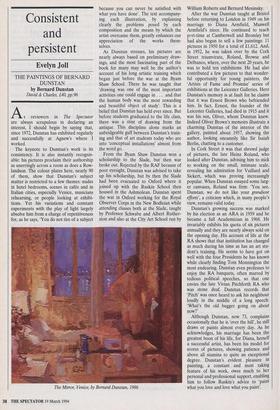Consistent and persistent
Evelyn Joll
THE PAINTINGS OF BERNARD DUNSTAN by Bernard Dunstan David & Charles, 140, pp.96 As reviewers in The Spectator are always scrupulous in declaring an interest, I should begin by saying that, since 1972, Dunstan has exhibited regularly and successfully at Agnew's where I worked.
The keynote to Dunstan's work is its consistency. It is also instantly recognis- able: his pictures proclaim their authorship as unerringly across a room as does a Row- landson. The colour plates here, nearly 90 of them, show that Dunstan's subject matter is restricted to a few themes: nudes in hotel bedrooms, scenes in cafés and in Italian cities, especially Venice, musicians rehearsing, or people looking at exhibi- tions. Yet his variations and constant experiments with the play of light largely absolve him from a charge of repetitiveness for, as he says, 'You do not tire of a subject because you can never be satisfied with what you have done'. The text accompany- ing each illustration, by explaining clearly the problems posed by each composition and the means by which the artist overcame them, greatly enhances our appreciation of the works them- selves.
As Dunstan stresses, his pictures are nearly always based on preliminary draw- ings, and the most fascinating part of the book for many may well be the author's account of his long artistic training which began just before the war at the Byam Shaw School. There he was taught that `drawing was one of the most important activities one could engage in . . . and that the human body was the most rewarding and beautiful object of study'. This is a belief that Dunstan has held ever since. But before students graduated to the life class, there was a stint of drawing from the antique. This discipline alone marks an unbridgeable gulf between Dunstan's train- ing and that of art students today who are into 'conceptual installations' almost from the word go.
From the Byam Shaw Dunstan won a scholarship to the Slade, but' then war broke out. Rejected by the RAF because of poor eyesight, Dunstan was advised to take up his scholarship, but by then the Slade had been evacuated to Oxford where it joined up with the Ruskin School then housed in the Ashmolean. Dunstan spent the war in Oxford working for the Royal Observer Corps in the New Bodleian while attending classes both at the. Slade, taught by Professor Schwabe and Albert Ruther- ston and also at the City Art School run by The Mirror, Venice, by Bernard Dunstan, 1986 William Roberts and Bernard Meninsky.
After the war Dunstan taught at Bristol before returning to London in 1949 on his marriage to Diana Armfield, Maxwell Armfield's niece. He continued to teach port-time at Camberwell and Bromley but had also begun to sell a few paintings: 11 pictures in 1950 for a total of £1,612. And, in 1952, he was taken over by the Cork Street triumvirate, Roland, Browse and Delbanco, where, over the next 20 years, he was to hold ten exhibitions. He had also contributed a few pictures to that wonder- ful opportunity for young painters, the `Artists of Fame and Promise' series of exhibitions at the Leicester Galleries. Here Dunstan's memory is at fault for he claims that it was Ernest Brown who befriended him. In fact, Ernest, the founder of the Leicester Galleries, had died in 1915 and it was his son, Oliver, whom Dunstan knew. Indeed Oliver Brown's memoirs illustrate a charming Dunstan of the interior of the gallery, painted about 1957, showing the author, looking uncannily like Sir Isaiah Berlin, chatting to a customer.
In Cork Street it was that shrewd judge of pictures, the late Heinz Roland, who looked after Dunstan, advising him to stick to working on the small, intimate scale, revealing his admiration for Vuillard and Sicken, which was proving increasingly popular. When Dunstan essayed some larg- er canvases, Roland was firm: `You see, Dunstan, we do not like your grandiose efforts', a criticism which, in many people's view, remains valid today.
Dunstan's growing success was marked by his election as an ARA in 1959 and he became a full Academician in 1968. He invariably exhibits his quota of six pictures annually and they are nearly always sold on the opening day. His account of life at the RA shows that that institution has changed as much during his time as has an art stu- dent's training. He seems to have got on well with the four Presidents he has known while clearly finding Tom Monnington the most endearing. Dunstan even professes to enjoy the RA banquets, often marred by tedious political speeches, so that one envies the late Vivian Pitchforth RA who was stone deaf. Dunstan records that `Pitch' was once heard to ask his neighbour loudly in the middle of a long speech: `What's the old bugger going on about now?'
Although Dunstan, now 73, complains occasionally that he is 'over the hill', he still draws or paints almost every day. As he acknowledges, his marriage has been the greatest boon of his life, for Diana, herself a successful artist, has been his model for scores of pictures, showing patience and above all stamina to quite an exceptional degree. Dunstan's evident pleasure in painting, a constant and most taking feature of his work, owes much to her personal and professional support, enabling him to follow Ruskin's advice to 'paint what you love and love what you paint'.


























































 Previous page
Previous page